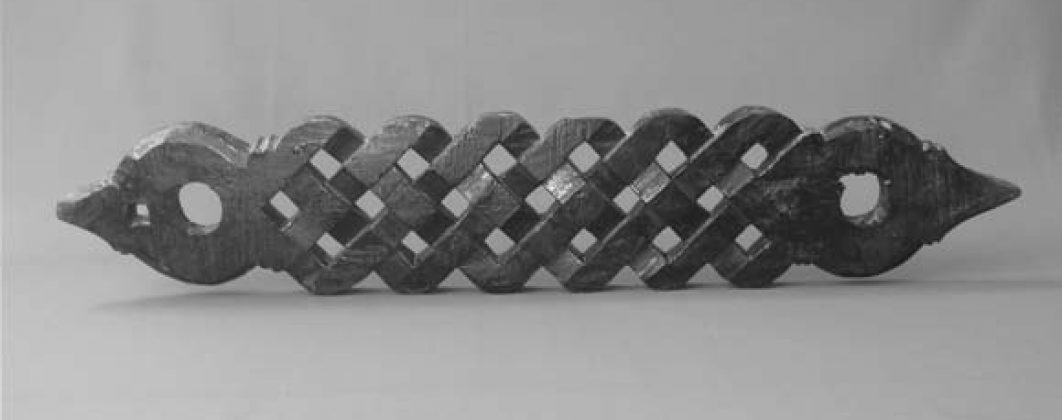

Ancient Indian civilization has passed on through generations to modern times a simple cradle made out of cloth in which the babies love to sleep. This cloth cradle is basically a cloth hammock created from a cotton cloth, from a simple cotton dhoti or a sari tied to a hook and hung from the ceiling to a provision made for this purpose. The baby relates the swinging movements of the cradle with the gentle swinging movements he experienced while he was in the cosy comfort of the mother’s womb corresponding to the mother’s movements. Any baby will be blissfully happy to sleeping in the cloth cradle.

The only inconvenience in cotton hanging type cradle is putting the baby inside the cradle and taking the baby out of the cradle. This is because the cradle has no sufficient opening for placing and taking out the baby since both the sides of the cloth cradle hang down without any gap in-between them. The mother has to hold the baby in hands and create an opening using her elbows which is very inconvenient. To surmount this problem, some people use a cradle separator to create a wide gap in between the two sides so that the baby can be put in and put out of the cradle conveniently. I have collected a beautiful cradle separator with excellent design which I love to present it to you.



The design of the Antique Cradle Separator
I can never imagine that a mundane thing like a cradle separator can be so artistic.This only shows that art is an integral part of our daily life some time back and may be it is the reason our ancestors lived a holistic happy life compared to the present generation whose houses and utilities have mere functional value and do not have art or aesthetics value.
The cradle separator is made with a single block of wood with beautiful design. Its length is 28 inches, width is 5 inches and depth is ¾ inches. The design of the separator appears to have three parts. The two end parts are circular in shape with triangular projections. These circular end pieces have the holes through which the cloth is passed through for making the cradle. The middle part of the separator has woven design forming 18 holes and the entire design is hand carved. The carvings are done in such a way that it looks as though it is woven with 3 strands of flexible wood. It looks very fluid .There is a small square hole at one end of the plank and this hole is meant for hanging this plank to a nail when not in use. The width of each strand is ¾ inch. This separator also is used to hang some colourful items for the entertainment of the baby using the 18 holes design.

My experience with the Cotton Cradle
I was told that my mother kept me in a cotton hanging cradle when I was a baby in my maternal grandmother’s house at Korumilli located on the banks of river Godavari in east Godavari district of Andhra Pradesh, where I was born. It is a tradition and a common practice to put the babies in a hanging cradle during my younger days. I, myself have seen the colourful cradles hanging in the halls of our neighbours and relatives houses who had babies. I have grown in a cradle culture. When my mother moved over to my Paternal grandfather’s house at Someswaram some 30 kilometres from Korumilli, my grandfather arranged a wooden cradle hung with 4 iron chains from the wooden beam of our house for my sleeping. I still have those lovely iron chains in my collection though we lost the cradle, I don’t know how.

Later, when I was going to school riding a bicycle I used to see the ladies who were working in the rice fields on either sides of the road used to have a cotton cradle of color full cloth and hang it to the branch of the nearby tree or to the beam of the cattle shed in which their babies are laid to sleep while they work in the rice fields. They would come periodically to the cradle, take out the baby, feed the baby with their breast milk and lay the baby back into the cosy cradle. I have never seen or heard of an accident happening by way of baby falling from a cotton cradle and it is absolutely safe. In fact there are chances of an accident happening when babies are kept on a flat wooden cradle or on a sleeping cot with cushions around falling down by accident. The best way to silence a crying baby is to put him in the cotton cradle and give it few mild rocking movements. I bet the baby will sleep in minutes provided the baby’s belly is full. A month’s old baby needs only two things, milk and the cosy comfort of a cotton hanging cradle.
The cotton fabric cradle is called Battauyyala in Telugu. This is known as Tuniunjalin Tamil. It is known in the northern part of India as Palna, Dhooli, Jhoola and Dhola in Bengali.

What is the secret of the survival of Cloth Cradle through generations?
The secret is babies love to be rocked to sleep. The rocking movement is the extension of their cosy life they had in the mother’s womb and the cradle movements they enjoyed whenever the mother walked around. They relate the rocking movements of the cradle with the movements they experienced while in the security and safety of the mother’s womb. Thus the babies love the rhythm of the gentle movements of the cotton cloth cradle. Further when the baby is placed in the cloth cradle, the wait of the baby pulls the cloth around the baby creating a snug womb like atmosphere around him. Whenever the baby makes a movement, the cradle also swings inducing the baby back to sleep.
Some people say that sleeping in a cotton cradle will promote the baby’s head to develop into a beautiful, rounded shape as he would not be sleeping on a flat mattress. It is hygienic too. When the baby passes the urine, it falls down from the thin cotton cloth and dries up fast keeping the baby dry. Generations of mothers over centuries felt good about the benefits of cotton hanging cradle and they passed on the simple technique to their next generations. Even now it is the most desirable way of putting the baby to sleep in several houses in towns and villages of India.

Precautions to be taken for Cotton Cradle
The cloth cradles are very convenient to the mother, comfortable to the baby, easy to maintain, space saving and are economical provided some precautions are taken while using the same. The baby has to be positioned in the cradle with his back resting on the cradle. The baby should not be kept with the face down. Keep the bottom side of the cradle as low as possible towards the ground. Take enough precaution to ensure the baby does not turn to the sides or to the stomach. Watch the weight of the baby and ensure the quality of the cloth to be used taking into consideration the growing weight of the baby. Ensure that the cloth cradle is properly hooked so that there is no chance of it falling down.

How I got this Antique Cradle Separator
I got this wonderful Antique Cradle Separator from an antique dealer in Chettinadu, a region in Tamil Nadu where the prosperous Chettiar community live. Basically they are business people particularly in banking and education sectors. They are called natukotaichettiars since they have houses as big as a fortress. They live a very traditional life with the art surrounding their magnificent houses including artistic household items like this beautifully carved cradle separator. I have purchased this in the year 1972 from Karaikudi city of Chettinadu. It is with me since 40 years. I wonder for how many cradles it was used as a separator and who are the babies that slept in those cotton hanging cradles and how many eminent personalities this cradle has rocked when they were babies.

Copyright © 2021 YK Antiques Home Museum
One Response
Awesome! your house is looks like a museum. I am so excited to visit your place to see all your collection. Can we visit.
Even I am so interested to collect like you, could you please guide me to get antique objects.